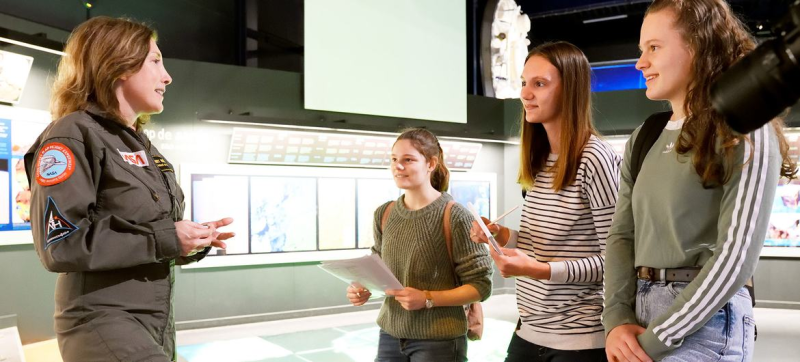- Gazans Welcome Trump Ceasefire Call as Hostages Set for Release |
- Conservative Takaichi Poised to Become Japan’s First Woman PM |
- Salahuddin accuses Jamaat of backing vested quarter to disrupt polls |
- Last boat in Gaza humanitarian flotilla intercepted by Israel |
- UN Marks World Space Week With Theme 'Living in Space' |
UN and Cosmic Girls Inspire Next Generation of Women in Space

Mindy Howard talks with girls about space.
Nuriya Maharjan first became interested in space exploration during a traditional coming-of-age ritual in which young girls of Nepal’s Indigenous Newar tribe emerge from 12 days of darkness to symbolically marry the sun.
Now 18, she is involved in aerospace projects with other young women through the Shakthi SAT initiative and is keen to explore the intersection between computer engineering and science, particularly artificial intelligence (AI), autonomous robotics, and embedded systems that control satellites, drones, and rockets.
“I’m learning things I once only dreamed of, and we’re going to launch our own satellite. How cool is that!” she told UN News.
Prospects at home in Nepal, an impoverished nation with a nascent space industry, remain limited.
“Our parents usually don’t want us to pursue ‘risky’ careers,” she said.
‘My interest is to make humans multiplanetary’
As a little girl growing up in Hasselt, Belgium, Kaat DeGros thought becoming an astronaut in the highly competitive, male-dominated space field would never happen.
Today, at 15, she has designed her own sustainable research base on Mars, hailed by the Oxford Academy of Excellence.
“My interest is to make humans multiplanetary,” she said.
Demystifying space careers
A new partnership between the Space4Women project of the UN Office for Outer Space Affairs (UNOOSA) and the Cosmic Girls Foundation is bringing together young women and girls like Maharjan and DeGros from across the globe to explore how they can shape the future of space and thrive in diverse roles, from space economics and law to engineering, policy, and innovation.
Over 30 girls participated in a global webinar in late July on “Demystifying Space Careers: Not Just Astronauts,” the first in a series of collaborations to unite UNOOSA’s global reach and Cosmic Girls’ grassroots network.
Two women leaders—a space economist at the European Bank for Reconstruction and Development and a legal officer at the Kenya Space Agency—shared practical advice on entering the sector and fielded questions on academic and professional paths, networking, accessing resources, and dealing with rejection.
Building a space ecosystem
The girls left with several key messages: be your own cheerleader, seek mentors and allies, stay disciplined but follow your passion, and join space communities.
“We are building an ecosystem that equips girls worldwide with STEM skills, astronaut training, and the mindset to innovate for humanity’s future among the stars,” said Mindy Howard, founder and CEO of the Netherlands- and US-based Cosmic Girls Foundation.
The partnership will also influence policymakers to adopt a new vision of the space sector where men and women are equal partners, said UNOOSA programme officer Anne-Claire Grossias.
“It’s a very human-focused project. Through this connection, we can move toward gender equality,” she explained.
Landmark study: Space sector still gender blind
Despite progress, women remain significantly under-represented in the field, especially in leadership roles. Only 11 per cent of astronauts are women, and they represent just 30 per cent of the workforce in public space sector organizations, according to the Space4Women project’s 2024 landmark study on gender equality.
Ensuring a meaningful role for women not only boosts productivity and innovation but also leads to greater global collaboration, consensus-building, and lasting peace.
The study was conceived at the 2023 Space4Women Expert Meeting, which prepared the UN’s first gender mainstreaming toolkit to help space organizations dismantle bias and create environments where women can succeed alongside male colleagues.
Fostering the female astronaut pipeline
Since its inception in 2017, the Space4Women project has mentored over 270 girls from 68 countries.
Howard has brought together nearly 1,000 girls from 139 countries through her Cosmic Girls educational and networking forum. With programme partners across Africa, Asia, Europe, the Americas, and Oceania, the foundation has launched the first global competition to train six girls—one from each continent—with the rocket science knowledge, life skills, and mental preparedness to become astronauts. The grand prize for one winner is a trip to space.
“The competition is such a dream come true,” said DeGros. “It gave me hope that I will succeed as an astronaut and astrophysicist.”
Building confidence in a safe environment
Supporting girls from an early age in a welcoming, nurturing environment is crucial to help them gradually test the waters and bring collaborative approaches to problem-solving to the field, said Howard.
“Girls are often told by their parents they are not good enough, not smart enough. This is a safe environment for them to hone their skills, which will help them later on,” she said.
Already, the girls are feeling confident.
“This feels like something extraordinary—a real step towards a future I once thought was out of reach,” said Maharjan.
“I think there will be equality in space exploration in not so long of a time,” added DeGros.

